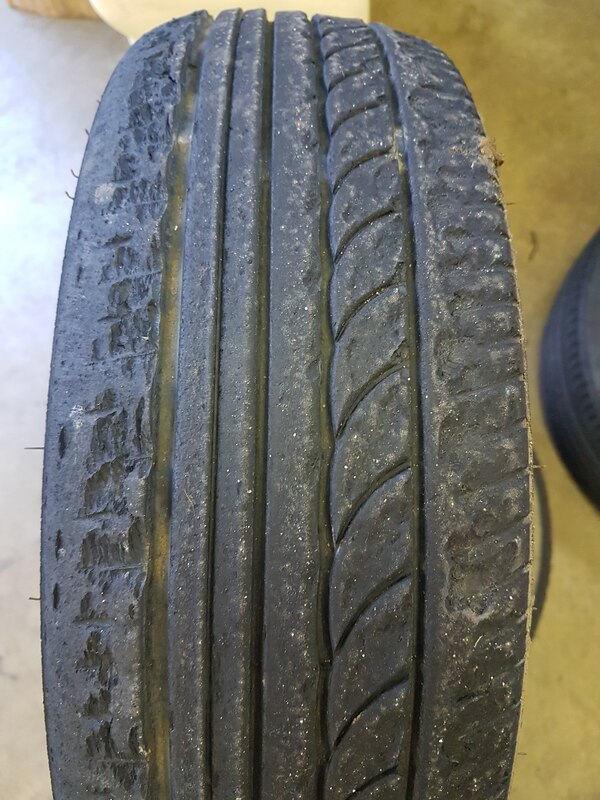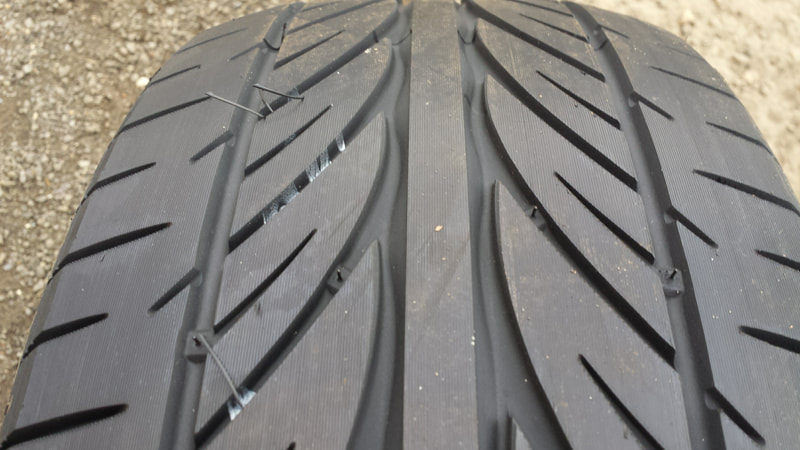This also can be a long and detailed subject, but like rubber compounds, I will try to cover the basics. Tread patterns generally fall into two types: those designed for loose surfaces such as mud and gravel where the tyre must dig in to get purchase (tractor tyres, gravel tyres and for that matter football boots) and then those designed for sealed surfaces (roads and tracks). Here, the tyre tread’s prime aim is to channel water from under the tyre and prevent aquaplaning. After all, you could have the cleverest compound in the world, but it is no use if it is not touching the ground. Just as there is no one compound that does it all, there has yet to be a tread pattern invented that delivers race pace in both wet and dry. To understand what makes a good wet tyre, first it needs to be understood what is happening. Water puts a barrier between the rubber and the road, meaning chemical grip is reduced. The tyre now needs to rely on mechanical grip much more.
The reason white lines on a circuit are so slippy in the wet is because there is reduced chemical grip and no mechanical grip as they are smooth so nothing for the tyre to dig into.
Putting a tread on a tyre allows water to escape from under the contact patch, but in doing so it is dividing up the surface of the tyre into smaller patches of rubber. As the road gets wetter, more water must be moved and so to cope, the gaps get bigger and the amount of rubber touching the road in the contact patch gets less.
The reason white lines on a circuit are so slippy in the wet is because there is reduced chemical grip and no mechanical grip as they are smooth so nothing for the tyre to dig into.
Putting a tread on a tyre allows water to escape from under the contact patch, but in doing so it is dividing up the surface of the tyre into smaller patches of rubber. As the road gets wetter, more water must be moved and so to cope, the gaps get bigger and the amount of rubber touching the road in the contact patch gets less.
Typical open tread of a wet bias road tyre.
TREAD MOVEMENT
Earlier we discussed that movement is needed in the rubber to build heat and because the tread divides the surface of the tyre into smaller blocks, the rubber can move around more easily and thus create more heat. The size and shape of these blocks has a direct effect on their movement. Small tread blocks move more than larger ones (and slicks move the least). This is the biggest compromise of treaded tyres, the requirements in the dry are pretty much the opposite in the wet. If the road is very wet, we want a tyre with an open pattern to displace water, and as the grip level is reduced and the water cools the rubber, there is little chance of overheating. A “race wet” would certainly be a soft compound rubber to make as much mechanical grip as possible. A road tyre, whilst not being a specific soft compound, benefits from having less rubber in the contact patch and so generates increased mechanical grip due to the weight of the car pressing that rubber into the road. The problems begin when the road dries..... Grip increases, cooling decreases, the treads flex more and more energy goes into the tyre. Temperatures rise. Everything that was going for the wet tyre starts to act against it. It is the typical scenario of the race driver trying to cool their wet tyres on a drying track to avoid a late pitstop. The tyre is overheating and going greasy.
You may have heard of tyre buffing or tyre shaving. This is a process that reduces the tread depth of a tyre. The purpose is to reduce movement in the tread block and prevent overheating, particularly if treaded tyres must be used in the dry. If done correctly it can result in a significant improvement in overall performance and, somewhat counter intuitively, longer life than if the tyre was not shaved. – As a side note, burnouts will not have the same effect. You will reduce the tread height, but the sustained overheating will just dry all the plasticiser oils that keep the rubber pliant, the net result is that the tyre will not generate the grip it should be capable of.
Earlier we discussed that movement is needed in the rubber to build heat and because the tread divides the surface of the tyre into smaller blocks, the rubber can move around more easily and thus create more heat. The size and shape of these blocks has a direct effect on their movement. Small tread blocks move more than larger ones (and slicks move the least). This is the biggest compromise of treaded tyres, the requirements in the dry are pretty much the opposite in the wet. If the road is very wet, we want a tyre with an open pattern to displace water, and as the grip level is reduced and the water cools the rubber, there is little chance of overheating. A “race wet” would certainly be a soft compound rubber to make as much mechanical grip as possible. A road tyre, whilst not being a specific soft compound, benefits from having less rubber in the contact patch and so generates increased mechanical grip due to the weight of the car pressing that rubber into the road. The problems begin when the road dries..... Grip increases, cooling decreases, the treads flex more and more energy goes into the tyre. Temperatures rise. Everything that was going for the wet tyre starts to act against it. It is the typical scenario of the race driver trying to cool their wet tyres on a drying track to avoid a late pitstop. The tyre is overheating and going greasy.
You may have heard of tyre buffing or tyre shaving. This is a process that reduces the tread depth of a tyre. The purpose is to reduce movement in the tread block and prevent overheating, particularly if treaded tyres must be used in the dry. If done correctly it can result in a significant improvement in overall performance and, somewhat counter intuitively, longer life than if the tyre was not shaved. – As a side note, burnouts will not have the same effect. You will reduce the tread height, but the sustained overheating will just dry all the plasticiser oils that keep the rubber pliant, the net result is that the tyre will not generate the grip it should be capable of.
|
The difference in wear and longevity between a shaved and unshaved tyre.
|
An unused shaved tyre.
|
Traditionally, tyre tread patterns were symmetrical, meaning the tyre was no different left or right or run either way round. As cars developed and tyres got wider, directional patterns emerged in the 90’s with chevrons intended to channel water from under the tyre to the outer edges but requiring the tyre to rotate in one direction only. While these still exist, the most recent developments are asymmetric tyres, where the pattern is different on the inside of the tyre to that on the outside. The concept is that as you accelerate, brake and corner, the tyre contact patch changes both in shape and position. When cornering the contact patch will move towards the outer edge of the tyre with a shape much like a bead of water, whilst in a straight line or under braking it will move to the centre, or with camber more inboard with more of a lozenge shape. This allows bigger, stiffer tread blocks on the outside of tyres for cornering and smaller blocks with more drainage on the inside for braking and to combat aquaplaning.
This is also a reason why for a hard-used tyre on circuit you would expect the outer edge to experience the most wear and that it is not necessarily a geometry issue when this is happening.
This brings me to probably the second most asked question on tyres. “What are they like in the wet?
Hopefully by now you will understand and realise this question is too simple. The tread pattern will have a significant bearing on the performance, and like compounds, have an operating window, big blocks that can take dry temperatures don’t cut through water easily, soft open treads for rain move around too much for precision in the dry and overheat, so at very least the question needs to include, “how wet?”
This is also a reason why for a hard-used tyre on circuit you would expect the outer edge to experience the most wear and that it is not necessarily a geometry issue when this is happening.
This brings me to probably the second most asked question on tyres. “What are they like in the wet?
Hopefully by now you will understand and realise this question is too simple. The tread pattern will have a significant bearing on the performance, and like compounds, have an operating window, big blocks that can take dry temperatures don’t cut through water easily, soft open treads for rain move around too much for precision in the dry and overheat, so at very least the question needs to include, “how wet?”





